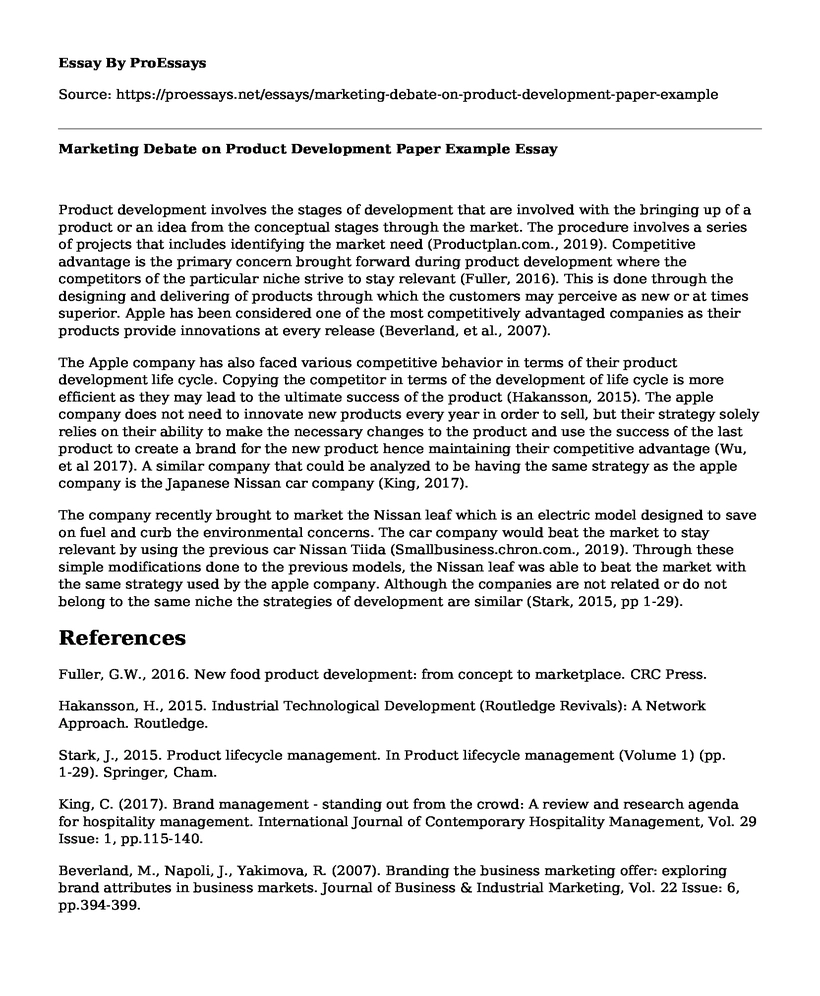Product development involves the stages of development that are involved with the bringing up of a product or an idea from the conceptual stages through the market. The procedure involves a series of projects that includes identifying the market need (Productplan.com., 2019). Competitive advantage is the primary concern brought forward during product development where the competitors of the particular niche strive to stay relevant (Fuller, 2016). This is done through the designing and delivering of products through which the customers may perceive as new or at times superior. Apple has been considered one of the most competitively advantaged companies as their products provide innovations at every release (Beverland, et al., 2007).
The Apple company has also faced various competitive behavior in terms of their product development life cycle. Copying the competitor in terms of the development of life cycle is more efficient as they may lead to the ultimate success of the product (Hakansson, 2015). The apple company does not need to innovate new products every year in order to sell, but their strategy solely relies on their ability to make the necessary changes to the product and use the success of the last product to create a brand for the new product hence maintaining their competitive advantage (Wu, et al 2017). A similar company that could be analyzed to be having the same strategy as the apple company is the Japanese Nissan car company (King, 2017).
The company recently brought to market the Nissan leaf which is an electric model designed to save on fuel and curb the environmental concerns. The car company would beat the market to stay relevant by using the previous car Nissan Tiida (Smallbusiness.chron.com., 2019). Through these simple modifications done to the previous models, the Nissan leaf was able to beat the market with the same strategy used by the apple company. Although the companies are not related or do not belong to the same niche the strategies of development are similar (Stark, 2015, pp 1-29).
References
Fuller, G.W., 2016. New food product development: from concept to marketplace. CRC Press.
Hakansson, H., 2015. Industrial Technological Development (Routledge Revivals): A Network Approach. Routledge.
Stark, J., 2015. Product lifecycle management. In Product lifecycle management (Volume 1) (pp. 1-29). Springer, Cham.
King, C. (2017). Brand management - standing out from the crowd: A review and research agenda for hospitality management. International Journal of Contemporary Hospitality Management, Vol. 29 Issue: 1, pp.115-140.
Beverland, M., Napoli, J., Yakimova, R. (2007). Branding the business marketing offer: exploring brand attributes in business markets. Journal of Business & Industrial Marketing, Vol. 22 Issue: 6, pp.394-399.
Wu, Kim, Chen, Johnson (2017). Attitudes toward crowdsourced, community-involved new product development. Journal of Fashion Marketing and Management: An International Journal, Vol. 21 Issue: 4, pp.453-467.
Smallbusiness.chron.com. (2019). Examples of Product Development Strategy. [online] Available at: https://smallbusiness.chron.com/examples-product-development-strategy-3219.html [Accessed 12 Apr. 2019].
Productplan.com. (2019). What Is Product Development? Definition & Examples. [online] Available at: https://www.productplan.com/what-is-product-development/ [Accessed 12 Apr. 2019].
Cite this page
Marketing Debate on Product Development Paper Example. (2022, Dec 22). Retrieved from https://proessays.net/essays/marketing-debate-on-product-development-paper-example
If you are the original author of this essay and no longer wish to have it published on the ProEssays website, please click below to request its removal:
- Innovation and Competitive Analysis of Chipotle Mexican Grill
- Principles of Consumer Service Paper Example
- Essay Example on My Leadership Skills: Growing & Developing Annually
- Essay on Gaining Control of Your Free Time: Laura Vanderkam
- Paper Example on Strategy and Decision-Making: Keys to Business Success
- Essay Example on Airbnb's Journey: From Struggles to Success
- Essay Example an Start an E-Commerce Business: Shop Conveniently From Home







